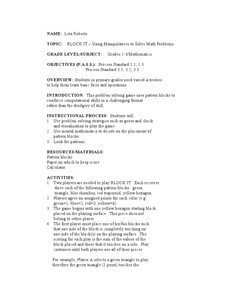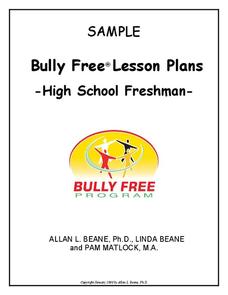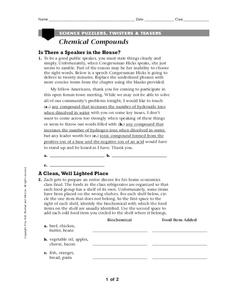Curated OER
The Crucible
Learners participate in a layered curriculum unit. Credit is earned for learning, which comes about through listening, discussion, reading, and/or doing. They are verbally assessed for each activity chosen to complete.
Judicial Learning Center
Your 4th Amendment Rights
Americans love to learn about their rights, especially those that protect them from the government's power to invade their privacy. Young people are especially engaged by this topic. An informative lesson explores four Supreme Court...
Facing History and Ourselves
The Nazis in Power: Propaganda and Conformity
The Nazis used the power of propaganda to encourage confirmative views and the discrimination of Jews. A social studies resource illustrates these issues through discussion, image analysis, and a writing exercise.
Curated OER
Igneous Rock Formation
Fifth graders use the computer lab to search for answers to questions on their workshet. They discuss the creation of igneouss rocks and listen as the teacher lectures about lava. Students follow directions to mix a batch of salt dough...
Curated OER
Fantasies and Myths
Fourth graders examine different types of literature, specifically myths and fantasy. They listen to "The Giving Tree", identify in which genre of literature it belongs, and view several myths on a website. At end of instructional...
Curated OER
School-Home Links: Alike and Different Sounds
For this letter sounds worksheet, students point to each letter and say the sound that it makes. Students then tell which sound is the row is different.
Curated OER
Block It: Using a Manipulative to Solve Math Problems
Students practice using visuals to solve math problems. In this math manipulative lesson, students utilize pattern blocks to participate in a class game in which geometric shapes touch other player's pieces. Students gain points based on...
Curated OER
Property: Ownership, Respect, and Responsibilty
Students brainstorm objects that belong to themselves, classmates, the teacher, and the school. They discuss and rank what happens when personal property is damaged.
Curated OER
The Media and Parliamentarians / Lessons 1 : The Medias and Parliamentarians
Eleventh graders recognize the paradox which exists in the views of Parliamentarians: the perception that the media misrepresents in its reporting of Parliamentary business the view of Parliamentarians.
Curated OER
Opportunity for Students in the Parliamentary System
Students explore youth programs which promote Canadian citizenship and democracy. They study Canadian parliamentary institutions.
Curated OER
Democracy through Parliamentary Committees / Lessons 2 : Selecting and Studying a Specific Bill
High schoolers appreciate and respect the advantages of Canada's parliamentary system. They engage in a lesson which illustrates the important role committees play in drafting bills.
Curated OER
First Grade Math Review
In this first grade math review worksheet, 1st graders complete problems on place value, fractions, counting, shapes, and more. Students complete 25 multiple choice questions.
Curated OER
Cycling of Matter and Energy
These twenty various types of questions related to the cycling of matter and energy require students to match each definition in column 1 with the correct vocabulary term from column 2. Then, students explain what is being demonstrated...
Curated OER
Using the Internet - Art and Design
An interesting resource that might work best in an upper level art course, this handout provides a list of nine websites where young artists can read and study about all forms of art. These online resources range from a dictionary of...
Curated OER
Pyramids and Prisms: Guler's Formula
Sixth graders detect and categorize the attributes of geometric shapes to solve problems. In this geometry instructional activity, 6th graders construct a variety of polyhedra. Students recognize the relationships between two...
Curated OER
Rock-forming Minerals
In this mineral worksheet, students use a table of information about rock-forming minerals to complete 10 short answer questions.
Curated OER
Puberty/Adolescence, Day 4: "Will I Fit in?"
What are healthy friendships? What makes a friendship unhealthy? There are several worksheets for your high schoolers to do to answer some of these questions and more about their friends and ideas about friendship. Inspire some great...
Bully Free Systems
Bully Free Lesson Plans—Seventh Grade
Having a hard time defining bullying with your seventh graders? Discuss the different types of behavior one would see in a bullying situation with a series of lessons, worksheets, and group activities.
Bully Free Systems
Bully Free Lesson Plans—Eighth Grade
Middle schoolers are likely very familiar with the concept of bullying and cliques. Discuss their experiences and brainstorm ways to handle peer conflict and feelings of exclusion with a poem that focuses on bullying, and a second...
Bully Free Systems
Bully Free Lesson Plans—Ninth Grade
"Bullying and Prejudice" and "Do You Cyber Bully," two lessons from a complete Bully Free program, serve as samples of the approach used in a unit designed to bring awareness to and to combat bullying. Each instructional...
Bully Free Systems
Bully Free Lesson Plans—11th Grade
It takes courage to stand up to bullies. Two sample lessons from a complete Bully Free curriculum, "Courageous and Brave Bystanders" and "Assertiveness Skills for Bullied Students and Empowered Bystanders" provide participants with...
K12 Reader
The Important Apostrophe: Their, They’re, and There
They're going to be there with their family. Class members practice using and identifying the correct use of they're, there, and their with a skills practice worksheet. The top half of the worksheet gives brief background information on...
Bully Free Systems
Bully Free Lesson Plans—12th Grade
Two sample lessons from a curriculum unit on bullying provide high school seniors with an opportunity to assess their online and cell phone behavior and to consider how they can offer support to bullied students. Each plan includes an...
Curated OER
Chemical Compounds
In this chemistry worksheet, students identify 3 different chemical compounds, 3 identify biochemical products, 4 identify terms, and 2 identify atomic symbols.

























